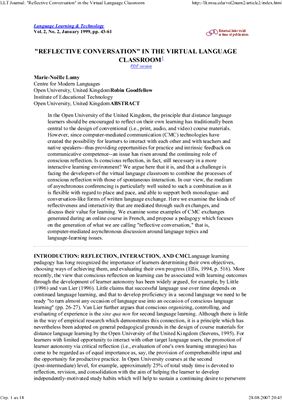Электронный ресурс
In the Open University of the United Kingdom, the principle that distance language leaers should be encouraged to reflect on their own leaing has traditionally been
central to the design of conventional (i.e. , print, audio, and video) course materials.
However, since computer-mediated communication (CMC) technologies have
created the possibility for leaers to interact with each other and with teachers and
native speakers--thus providing opportunities for practice and intrinsic feedback on
communicative competence--an issue has risen around the continuing role of
conscious reflection. Is conscious reflection, in fact, still necessary in a more
interactive leaing environment? We argue here that it is, and that a challenge is
facing the developers of the virtual language classroom to combine the processes of
conscious reflection with those of spontaneous interaction. In our view, the medium
of asynchronous conferencing is particularly well suited to such a combination as it
is flexible with regard to place and pace, and able to support both monologue- and
conversation-like forms of written language exchange. Here we examine the kinds of
reflectiveness and interactivity that are mediated through such exchanges, and
discuss their value for leaing. We examine some examples of CMC exchanges
generated during an online course in French, and propose a pedagogy which focuses
on the generation of what we are calling "reflective conversation, " that is,
computer-mediated asynchronous discussion around language topics and
language-leaing issues.
In the Open University of the United Kingdom, the principle that distance language leaers should be encouraged to reflect on their own leaing has traditionally been
central to the design of conventional (i.e. , print, audio, and video) course materials.
However, since computer-mediated communication (CMC) technologies have
created the possibility for leaers to interact with each other and with teachers and
native speakers--thus providing opportunities for practice and intrinsic feedback on
communicative competence--an issue has risen around the continuing role of
conscious reflection. Is conscious reflection, in fact, still necessary in a more
interactive leaing environment? We argue here that it is, and that a challenge is
facing the developers of the virtual language classroom to combine the processes of
conscious reflection with those of spontaneous interaction. In our view, the medium
of asynchronous conferencing is particularly well suited to such a combination as it
is flexible with regard to place and pace, and able to support both monologue- and
conversation-like forms of written language exchange. Here we examine the kinds of
reflectiveness and interactivity that are mediated through such exchanges, and
discuss their value for leaing. We examine some examples of CMC exchanges
generated during an online course in French, and propose a pedagogy which focuses
on the generation of what we are calling "reflective conversation, " that is,
computer-mediated asynchronous discussion around language topics and
language-leaing issues.

